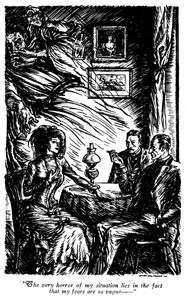 |
 |
|
Waterloo Station,
or the London & Southwestern Railway Terminus,
is at the top left of the map |
 |
Illustration from
the American reprint |
"…and the estates extended over the borders into Berkshire
in the north, and Hampshire in the west."
That is, the estate was so large it extended into two neighboring counties.
"…in the days of the Regency."
Between 1811 and 1820, the future King George IV ruled as Regent for his father, George III, who suffered from periodic insanity.
"…and went out to Calcutta…."
The capital of Britain's Indian colony.
"Violence of temper approaching to mania has been hereditary in the men of the family, and in my stepfather's case it had, I believe, been intensified by his long residence in the tropics."
The self-justifying mythology surrounding British colonial rule of India centered on the terrible "trials" the British suffered for the sake of "civilizing" the Indian people. Chief among these "trials" was the tropical climate (with its attendant diseases, like malaria), which was considered to be bad for the British "constitution," and sometimes to be the cause of madness.
"He had no friends at all save the wandering gipsies, and he would
give these vagabonds leave to encamp upon the few acres of bramble-covered
land which represent the family estate, and would accept in return
the hospitality of their tents, wandering away with them sometimes
for weeks on end."
The "gipsies" (gypsies), or Roma, as they prefer to be called today,
are a nomadic people from northern India who migrated west to Europe
in the 14th century. In Conan Doyle's time, their true
origins were unknown, but there were many theories. Their dark skin,
itinerant lives, and different customs made them convenient scapegoats
for problems without an obvious cause: thefts, well-poisoning, livestock
deaths, etc. The fact that Dr. Roylott lives with the gypsies would
make him suspect in the eyes of many of Conan Doyle's readers.
"He has a passion also for Indian animals, which are sent over to him by a correspondent, and he has at this moment a cheetah and a baboon…."
While cheetahs do exist in India, baboons are found only in Africa.
"…who lives near Harrow…."
Harrow is a northwest borough of London, bordering on Hertfordshire.
|
| |
|
| |













